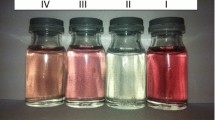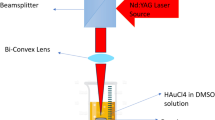Abstract
Core–shell nanoparticles, comprising gold nanoparticles (AuNPs) and titanium oxide nanoparticles (TiO2–NPs), were synthesized using pulsed laser ablation. This study examined the characteristics of these nanoparticles at three different composition ratios: 25% Au–75% TiO2, 50% Au–50% TiO2, and 75% Au–25% TiO2. We explored the resulting nanocomposite’s ultraviolet (UV) absorption and transmittance, analyzing the results through transmission electron microscopy (TEM) and spectroscopic techniques. The characteristics of the synthesized core–shell NPs exhibited significant variation depending on the ratios of Au and Ti examined. Notably, we observed an absorption peak at 530 nm. Interestingly, core–shell NPs with a higher concentration of Au displayed increased UV absorption, indicating enhanced UV absorption characteristics. TEM imaging unveiled the morphology of the synthesized core–shell NPs. The adjustment in the ratio of the original NPs to introduce core–shell NPs contributed to the synthesis of more efficient nanoparticles. These findings have potential implications for developing innovative materials with improved UV absorption capabilities, particularly in biomedical applications.





Similar content being viewed by others
References
N. Elahi, M. Kamali, M.H. Baghersad, Recent biomedical applications of gold nanoparticles: a review. Talanta 184, 537–556 (2018). https://doi.org/10.1016/j.talanta.2018.02.088
N. Joudeh, D. Linke, Nanoparticle classification, physicochemical properties, characterization, and applications: a comprehensive review for biologists. J. Nanobiotechnol. 20, 262 (2022). https://doi.org/10.1186/s12951-022-01477-8
I. Khan, K. Saeed, I. Khan, Nanoparticles: properties, applications and toxicities. Arab. J. Chem. 12, 908–931 (2019). https://doi.org/10.1016/j.arabjc.2017.05.011
Y. Khan, H. Sadia, S.Z. Ali Shah, M.N. Khan, A.A. Shah, N. Ullah, M.F. Ullah, H. Bibi, O.T. Bafakeeh, N.B. Khedher, Classification, synthetic, and characterization approaches to nanoparticles, and their applications in various fields of nanotechnology: a review. Catalysts 12, 1386 (2022). https://doi.org/10.3390/catal12111386
X. Hu, Y. Zhang, T. Ding, J. Liu, H. Zhao, Multifunctional gold nanoparticles: a novel nanomaterial for various medical applications and biological activities. Front. Bioeng. Biotechnol. 8, 990 (2020). https://doi.org/10.3389/fbioe.2020.00990
J. Milan, K. Niemczyk, M. Kus-Liśkiewicz, Treasure on the Earth—gold nanoparticles and their biomedical applications. Materials 15, 3355 (2022). https://doi.org/10.3390/ma15093355
V. Ramalingam, Multifunctionality of gold nanoparticles: plausible and convincing properties. Adv. Coll. Interface. Sci. 271, 101989 (2019). https://doi.org/10.1016/j.cis.2019.101989
R. Ghosh Chaudhuri, S. Paria, Core/shell nanoparticles: classes, properties, synthesis mechanisms, characterization, and applications. Chem. Rev. 112, 2373–2433 (2012). https://doi.org/10.1021/cr100449n
M. Focarete, A. Tampieri, Core-Shell Nanostructures for Drug Delivery and Theranostics: Challenges Strategies and Prospects for Novel Carrier Systems (Woodhead Publishing, 2018)
A. Sinharoy, P. Uddandarao, Zero-Valent Nanomaterials for Wastewater Treatment, in Advanced Application of Nanotechnology to Industrial Wastewater. (Springer, 2023), pp.53–73
N. Baig, I. Kammakakam, W. Falath, Nanomaterials: a review of synthesis methods, properties, recent progress, and challenges. Mater. Adv. 2, 1821–1871 (2021). https://doi.org/10.1039/D0MA00807A
S. Khan, M.K. Hossain, Classification and Properties of Nanoparticles, in Nanoparticle-Based Polymer Composites. (Elsevier, 2022), pp.15–54
L.I. Hussein, A.H. Abdaleem, M.S. Darwish, M.A. Elsawy, M.H. Mostafa, Chitosan/TiO2 nanocomposites: effect of microwave heating and solution mixing techniques on physical properties. Egypt. J. Chem. 63, 449–460 (2020). https://doi.org/10.21608/EJCHEM.2020.20908.2245
F. Yurt, K. Ocakoglu, M. Ince, S.G. Colak, O. Er, H.M. Soylu, C. Gunduz, C. Biray Avci, C. Caliskan Kurt, Photodynamic therapy and nuclear imaging activities of zinc phthalocyanine-integrated TiO2 nanoparticles in breast and cervical tumors. Chem. Biol. Drug Des. 91, 789–796 (2018). https://doi.org/10.1111/cbdd.13144
N.N. Vlasova, O.V. Markitan, Surface complexation modeling of biomolecule adsorptions onto Titania. Colloids Interfaces 3, 28 (2019). https://doi.org/10.3390/colloids3010028
L. Zhang, X. Liao, A. Fok, C. Ning, P. Ng, Y. Wang, Effect of crystalline phase changes in titania (TiO2) nanotube coatings on platelet adhesion and activation. Mater. Sci. Eng. C 82, 91–101 (2018). https://doi.org/10.1016/j.msec.2017.08.024
A. Sułek, B. Pucelik, M. Kobielusz, P. Łabuz, G. Dubin, J.M. Dąbrowski, Surface modification of nanocrystalline TiO2 materials with sulfonated porphyrins for visible light antimicrobial therapy. Catalysts 9, 821 (2019). https://doi.org/10.3390/catal9100821
M. Ha, J.-H. Kim, M. You, Q. Li, C. Fan, J.-M. Nam, Multicomponent plasmonic nanoparticles: from heterostructured nanoparticles to colloidal composite nanostructures. Chem. Rev. 119, 12208–12278 (2019). https://doi.org/10.1021/acs.chemrev.9b00234
M.J. Sailor, J.H. Park, Hybrid nanoparticles for detection and treatment of cancer. Adv. Mater. 24, 3779–3802 (2012). https://doi.org/10.1002/adma.201200653
W. Park, H. Shin, B. Choi, W.-K. Rhim, K. Na, D.K. Han, Advanced hybrid nanomaterials for biomedical applications. Prog. Mater. Sci. 114, 100686 (2020). https://doi.org/10.1016/j.pmatsci.2020.100686
V.P. Ananikov, Organic–inorganic hybrid nanomaterials. Nanomaterials 9, 1197 (2019). https://doi.org/10.3390/nano9091197
D. Ding, K. Liu, S. He, C. Gao, Y. Yin, Ligand-exchange assisted formation of Au/TiO2 Schottky contact for visible-light photocatalysis. Nano Lett. 14, 6731–6736 (2014). https://doi.org/10.1021/nl503585m
M. Miljevic, B. Geiseler, T. Bergfeldt, P. Bockstaller, L. Fruk, Enhanced photocatalytic activity of Au/TiO2 nanocomposite prepared using bifunctional bridging linker. Adv. Funct. Mater. 24, 907–915 (2014). https://doi.org/10.1002/adfm.201301484
N. Kamely, M. Ujihara, Confeito-like Au/TiO2 nanocomposite: synthesis and plasmon-induced photocatalysis. J. Nanoparticle Res. 20, 1–10 (2018). https://doi.org/10.1007/s11051-018-4276-5
P. Martins, S. Kappert, H. Le Nga, V. Sebastian, K. Kühn, M. Alves, L. Pereira, G. Cuniberti, M. Melle-Franco, S. Lanceros-Méndez, Enhanced photocatalytic activity of Au/TiO2 nanoparticles against ciprofloxacin. Catalysts 10, 234 (2020). https://doi.org/10.3390/catal10020234
C.B. Anucha, I. Altin, E. Bacaksiz, V.N. Stathopoulos, Titanium dioxide (TiO2)-based photocatalyst materials activity enhancement for contaminants of emerging concern (CECs) degradation: in the light of modification strategies. Chem. Eng. J. Adv. 10, 100262 (2022). https://doi.org/10.1016/j.ceja.2022.100262
V. Harish, M.M. Ansari, D. Tewari, M. Gaur, A.B. Yadav, M.-L. García-Betancourt, F.M. Abdel-Haleem, M. Bechelany, A. Barhoum, Nanoparticle and nanostructure synthesis and controlled growth methods. Nanomaterials 12, 3226 (2022). https://doi.org/10.3390/nano12183226
C.A. Charitidis, P. Georgiou, M.A. Koklioti, A.-F. Trompeta, V. Markakis, Manufacturing nanomaterials: from research to industry. Manuf. Rev. 1, 11 (2014). https://doi.org/10.1051/mfreview/2014009
W.K. Mahmood, R.K. Ibrahim, A.N. Naje, Surface plasmon resonance study of Ag nanoparticles colloidal. Iraqi J. Sci. 58, 2090–2097 (2017). https://doi.org/10.24996/ijs.2017.58.4B.12
A.A. Saeed, M.N. Abbas, W.F. El-Hawary, Y.M. Issa, B. Singh, A core-shell Au@ TiO2 and multi-walled carbon nanotube-based sensor for the electroanalytical determination of H2O2 in human blood serum and saliva. Biosensors 12, 778 (2022). https://doi.org/10.3390/bios12100778
S. Moniri, M.R. Hantehzadeh, M. Ghoranneviss, M.A. Asadabad, Study of the optical and structural properties of Pt nanoparticles prepared by laser ablation as a function of the applied electric field. Appl. Phys. A 123, 1–11 (2017). https://doi.org/10.1007/s00339-017-1311-9
A. Balachandran, S.P. Sreenilayam, K. Madanan, S. Thomas, D. Brabazon, Nanoparticle production via laser ablation synthesis in solution method and printed electronic application-A brief review. Res. Eng. (2022). https://doi.org/10.1016/j.rineng.2022.100646
R. Ibrahim, S. Ahmed, A. Naje, A. Suhail, Synthesis of silver nanoparticles by electrochemical method. J. Appl. Res. 3, 2249–2555 (2013)
P. Wang, L. Zhang, Z. Zhang, S. Wang, C. Yao, Influence of parameters on photodynamic therapy of Au@ TiO2–HMME core-shell nanostructures. Nanomaterials 12, 1358 (2022). https://doi.org/10.3390/nano12081358
Author information
Authors and Affiliations
Corresponding author
Additional information
Publisher's Note
Springer Nature remains neutral with regard to jurisdictional claims in published maps and institutional affiliations.
Rights and permissions
Springer Nature or its licensor (e.g. a society or other partner) holds exclusive rights to this article under a publishing agreement with the author(s) or other rightsholder(s); author self-archiving of the accepted manuscript version of this article is solely governed by the terms of such publishing agreement and applicable law.
About this article
Cite this article
Resen, D.A., Mahmood, A.I., Fakhri, M.A. et al. Optoelectronics properties enhancement in gold–titanium core–shell nanoparticles for UV absorption. J Opt (2023). https://doi.org/10.1007/s12596-023-01414-4
Received:
Accepted:
Published:
DOI: https://doi.org/10.1007/s12596-023-01414-4




